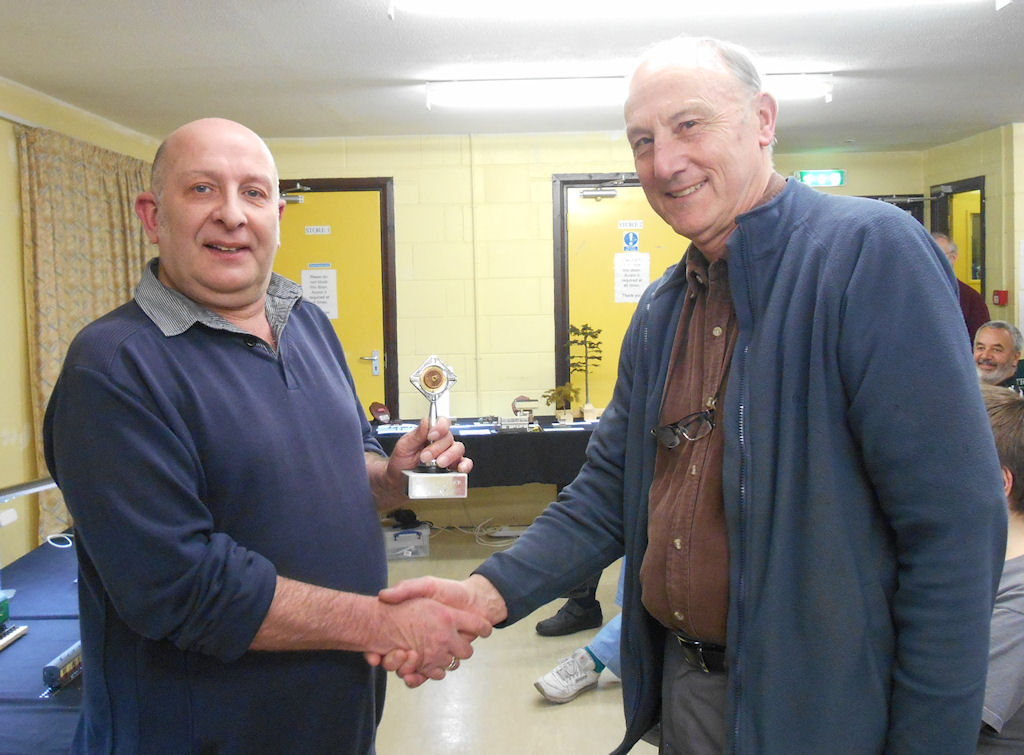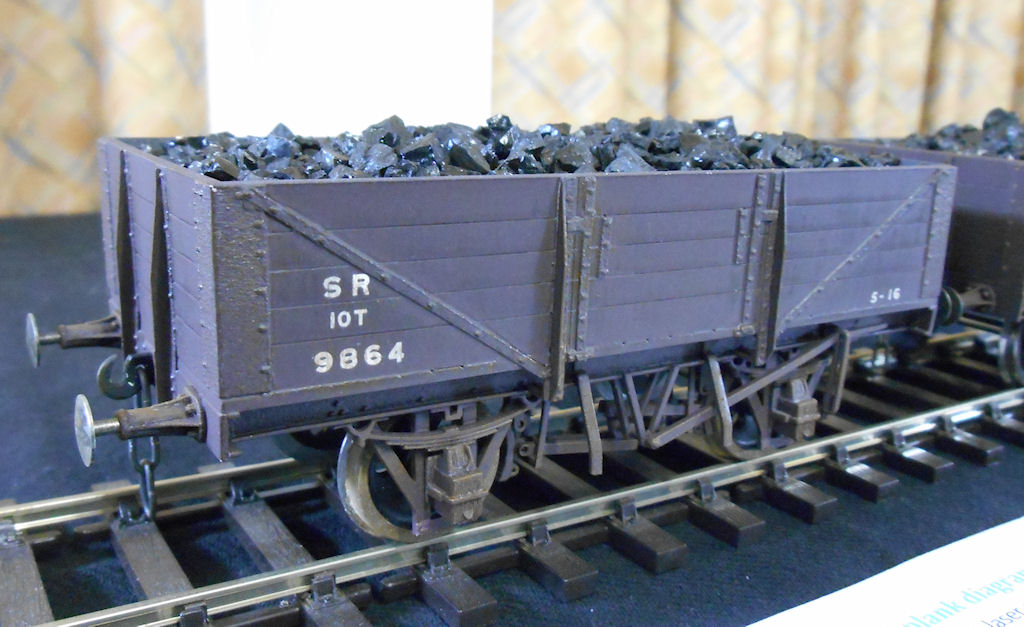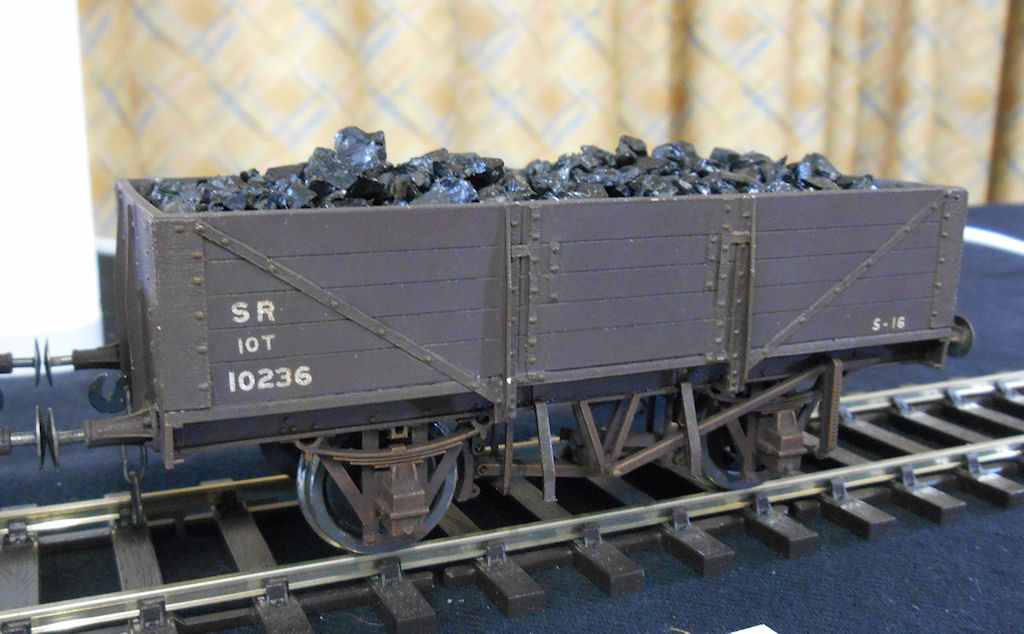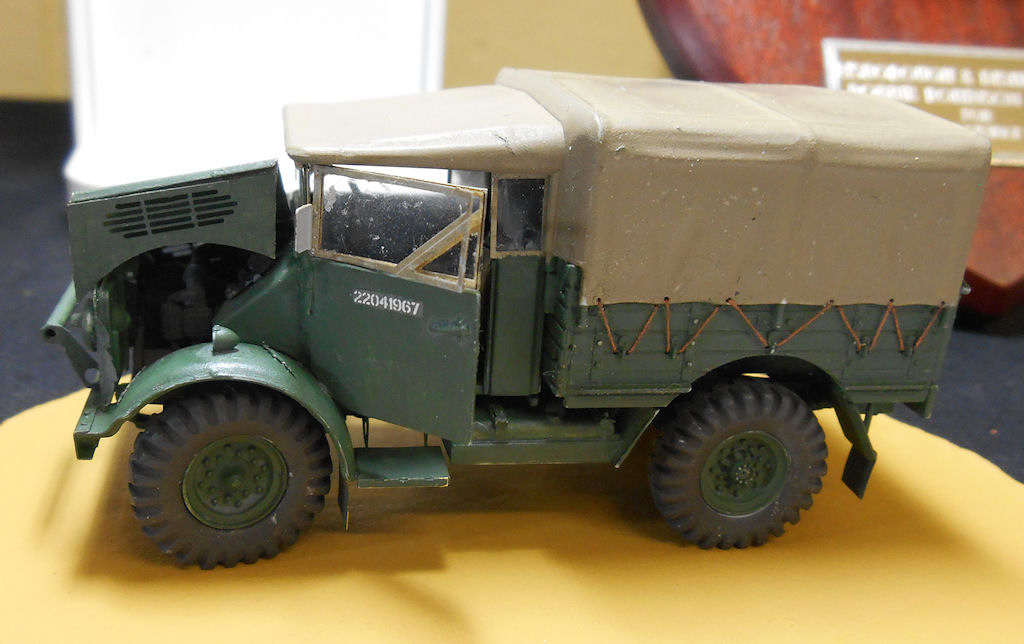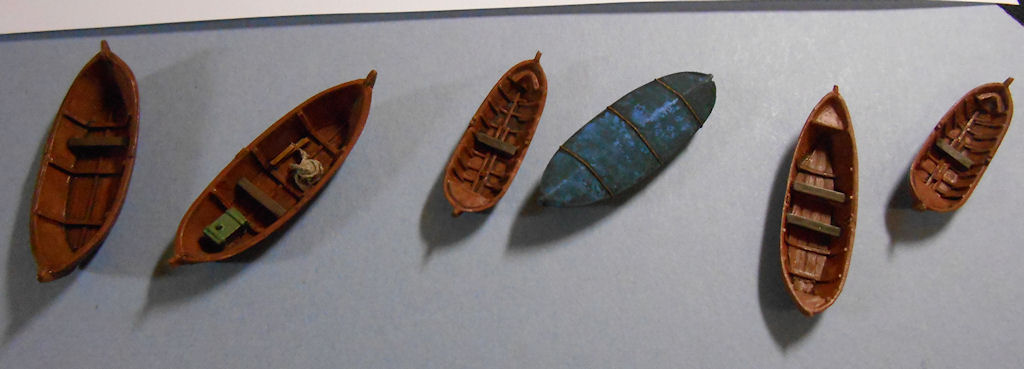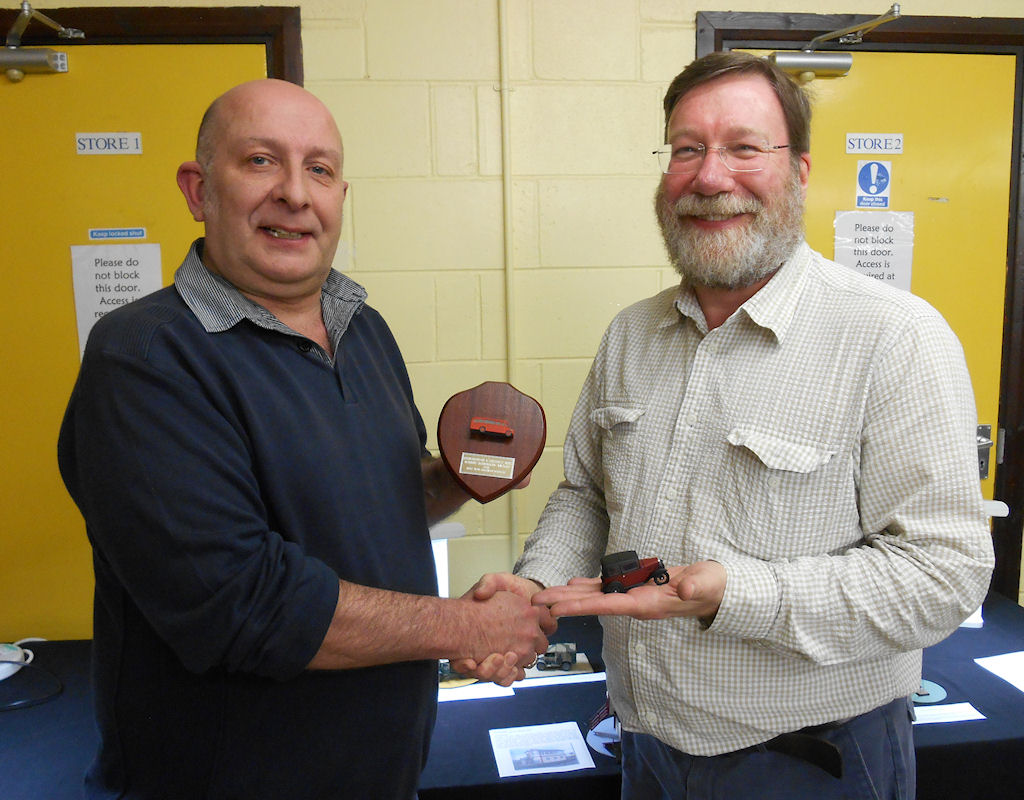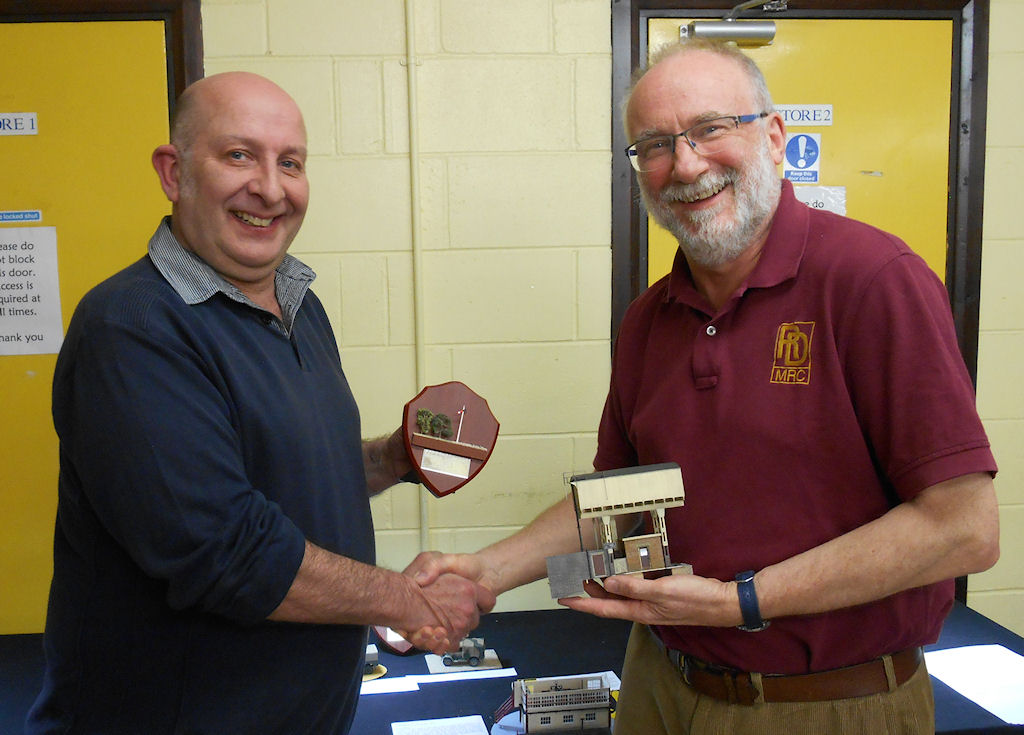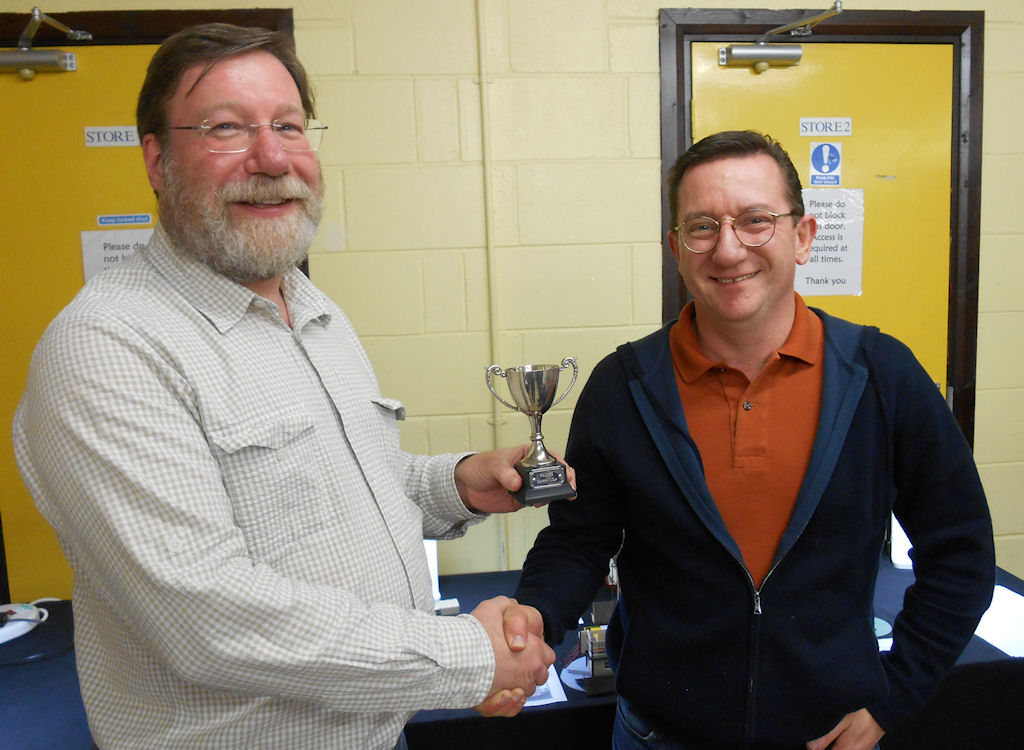Sidebar
Wheeltapper Competition 2016
Wheeltapper 2016 Competition took place on Friday the 1st of April. When invited guest judge and speaker Andy York from BRM came along to Judge the models on show and then to come up with the overall winner. British Railway Modelling (BRM) is a monthly Model Railway Magazine published by Warners Group, which has been published since 1993. For more details on BRM visit British Railway Modelling
Wheeltapper Trophy
Adrian Harford (right) receiving the Wheeltapper Trophy from Andy York for his scratch built Bulleid 3 Set coaches.
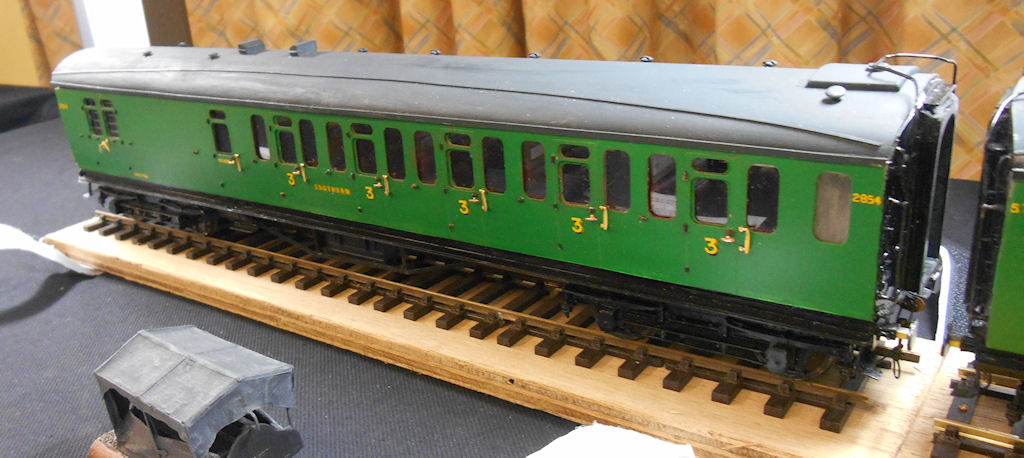
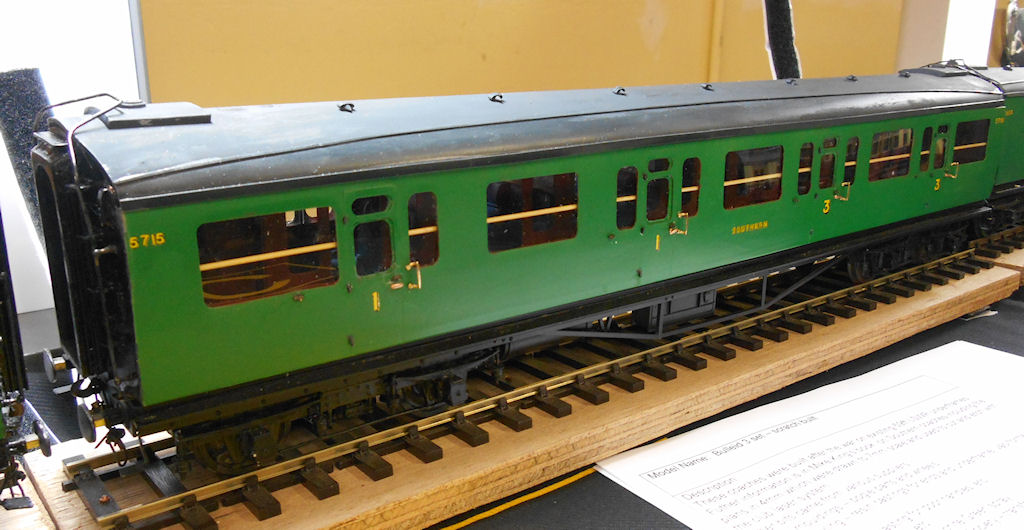
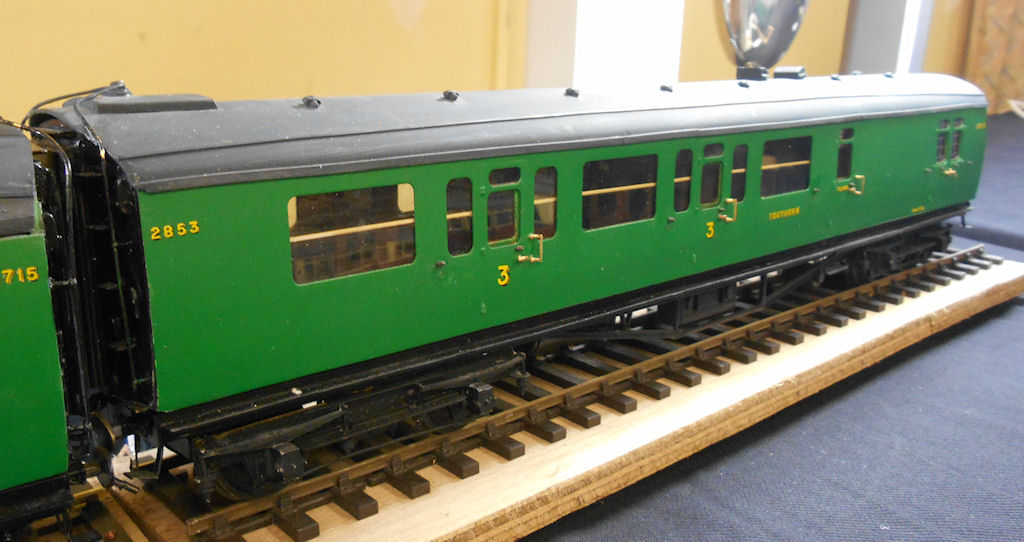 The Bullied 3 Set coaches were built after the war on existing 59ft LSWR underframes. Further information is provided in Mike King's Illustrated History of Southern Coaches including the plans in 4mm.
Adrian converted these drawings to 7mm scale and used these to cut and etch with the Club's laser cutter. Other parts came from a variety of suppliers including Roxey Mouldings - bogie parts and wheels, Peter Cowling - resin castings for ends and underframe, vac-formed roof and seats, Laurie Griffin - castings for door handles, etc., Slaters - couplings, etc., Precision Paints - Malachite Green spray, Historical Model Railway Society – transfers. Various other bits such as brass and styrene came from Adrian’s scrap box.
The Bullied 3 Set coaches were built after the war on existing 59ft LSWR underframes. Further information is provided in Mike King's Illustrated History of Southern Coaches including the plans in 4mm.
Adrian converted these drawings to 7mm scale and used these to cut and etch with the Club's laser cutter. Other parts came from a variety of suppliers including Roxey Mouldings - bogie parts and wheels, Peter Cowling - resin castings for ends and underframe, vac-formed roof and seats, Laurie Griffin - castings for door handles, etc., Slaters - couplings, etc., Precision Paints - Malachite Green spray, Historical Model Railway Society – transfers. Various other bits such as brass and styrene came from Adrian’s scrap box.
Steam Locomotives
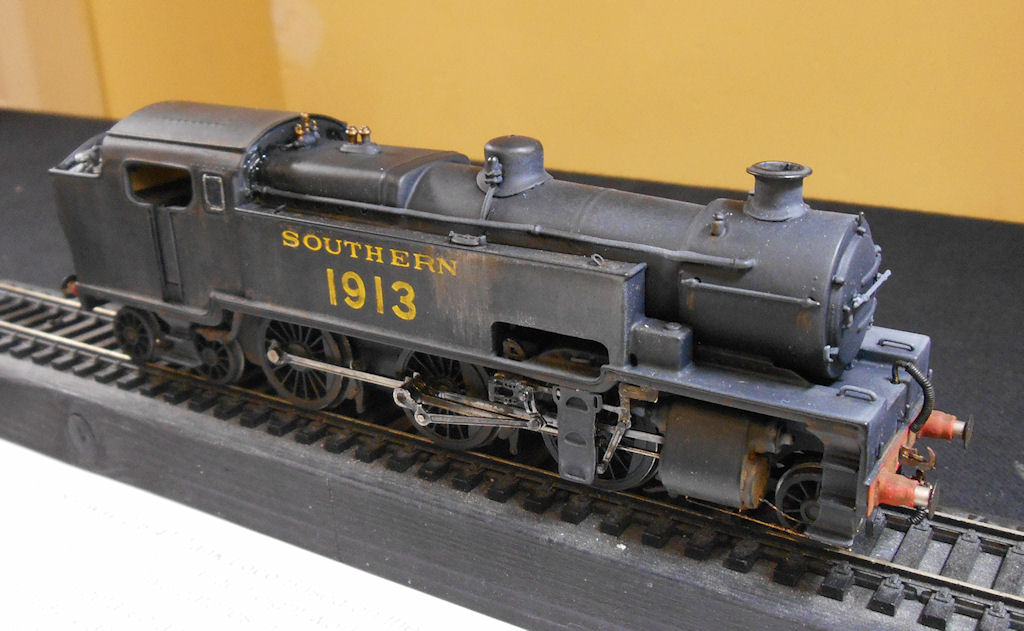 The winner of the Steam Locomotives competition was Roy Norton for his Southern Railway 2-6-4T Tank Loco. This loco is based on the 3 cylinder N1 2-6-0, which were designed for interchange freight workings with other railways north of the Thames. They were built in two batches in 1932 and 1935/36. The model is made from a detailed and modified South Eastern Finecast white metal kit mounted on a heavily adapted Bachmann N chassis. The challenge was to make a reasonable model from what one club member referred to as white s***!
The winner of the Steam Locomotives competition was Roy Norton for his Southern Railway 2-6-4T Tank Loco. This loco is based on the 3 cylinder N1 2-6-0, which were designed for interchange freight workings with other railways north of the Thames. They were built in two batches in 1932 and 1935/36. The model is made from a detailed and modified South Eastern Finecast white metal kit mounted on a heavily adapted Bachmann N chassis. The challenge was to make a reasonable model from what one club member referred to as white s***!
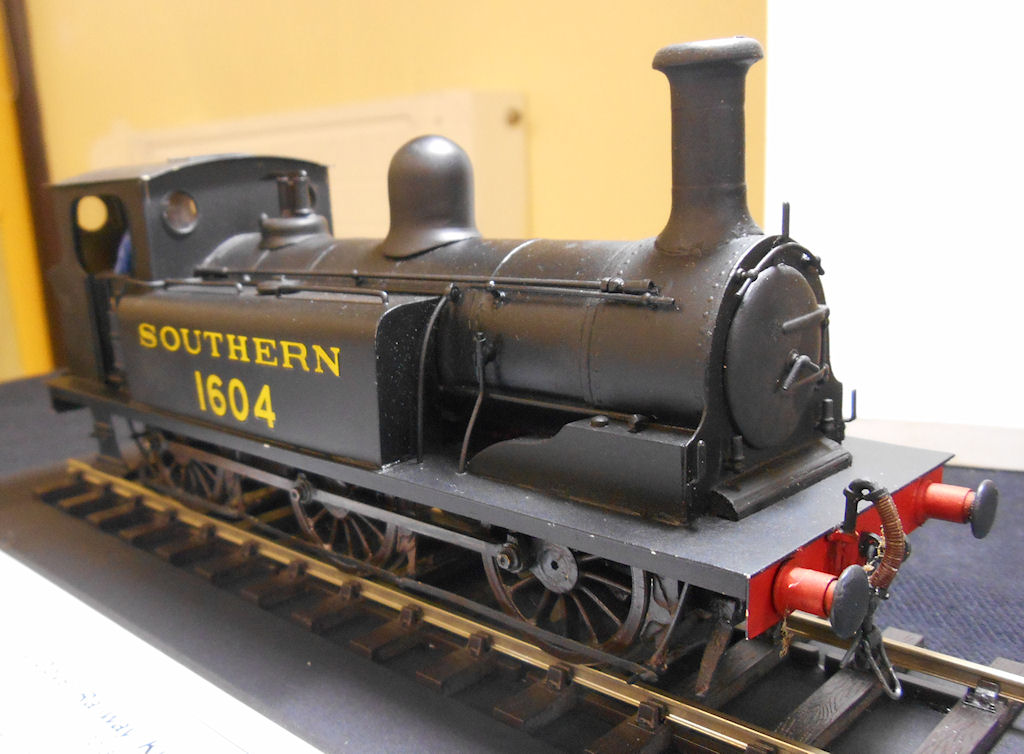 John Casson's Ex-London, Chatham and Dover Railway Kirtley Class 'T' No 1604 was a runner up. The T class locomotives were built in Longhedge Works in 1891, and withdrawn in November 1950. The model has been scratch built in nickel sliver and brass on a chassis from copper clad paxolin with brass bushes. The wheel are by Slaters, the 12Vdc motor by Canon with 40:1 worm/gear set. Buffers, boiler fittings etc, were turned from brass bar stock.
John Casson's Ex-London, Chatham and Dover Railway Kirtley Class 'T' No 1604 was a runner up. The T class locomotives were built in Longhedge Works in 1891, and withdrawn in November 1950. The model has been scratch built in nickel sliver and brass on a chassis from copper clad paxolin with brass bushes. The wheel are by Slaters, the 12Vdc motor by Canon with 40:1 worm/gear set. Buffers, boiler fittings etc, were turned from brass bar stock.
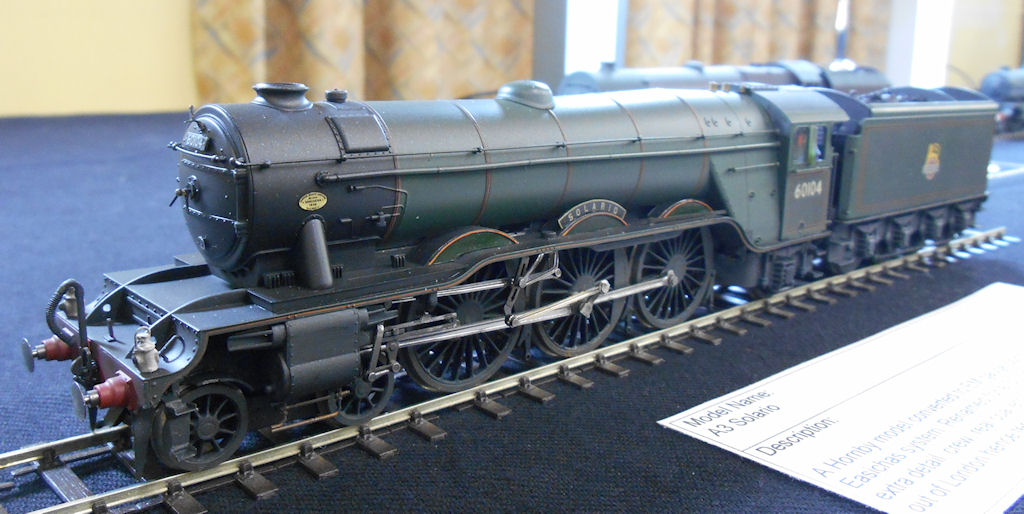 Tim Peacocks's A3 Solario was another runner up. This is a Hornby model which has been converted to EM gauge using the Brassmasters (not so) EasiChas system. Renamed for a GC line engine, lightly weathered with some extra detail, crew, real coal etc. Will be used on a down express so only 40' out of London hence still pretty full.
Tim Peacocks's A3 Solario was another runner up. This is a Hornby model which has been converted to EM gauge using the Brassmasters (not so) EasiChas system. Renamed for a GC line engine, lightly weathered with some extra detail, crew, real coal etc. Will be used on a down express so only 40' out of London hence still pretty full.
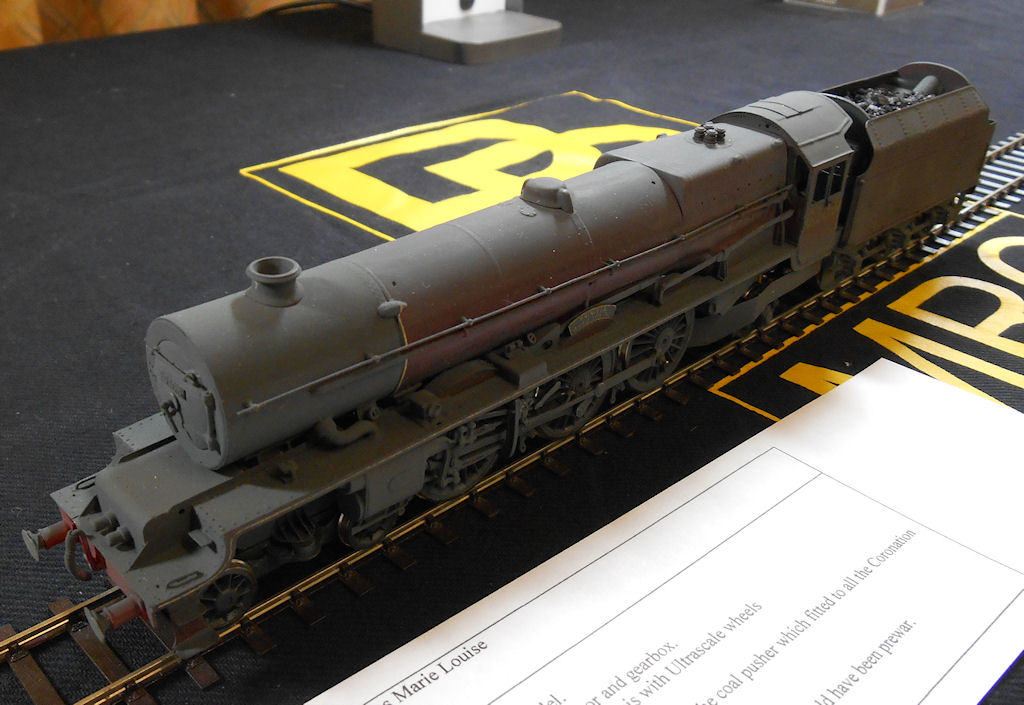 The first runner up from Phil Baxendale is his Coronation Pacific loco 6206 Princess Marie Louise. The Princess has the first example of the tender with the coal pusher which was fitted to all the Coronation pacifics. The model has been produced to P4 standards from a Brassmasters kit with Alan Gibson Wheels and a High Level motor and gearbox. The tender is a Comet body with a Lanarkshire sprung chassis with Ultrascale wheels. The loco has been painted in 1938 LMS red livery as it would have been at the end of 1947. The last repaint would have been pre-war.
The first runner up from Phil Baxendale is his Coronation Pacific loco 6206 Princess Marie Louise. The Princess has the first example of the tender with the coal pusher which was fitted to all the Coronation pacifics. The model has been produced to P4 standards from a Brassmasters kit with Alan Gibson Wheels and a High Level motor and gearbox. The tender is a Comet body with a Lanarkshire sprung chassis with Ultrascale wheels. The loco has been painted in 1938 LMS red livery as it would have been at the end of 1947. The last repaint would have been pre-war.
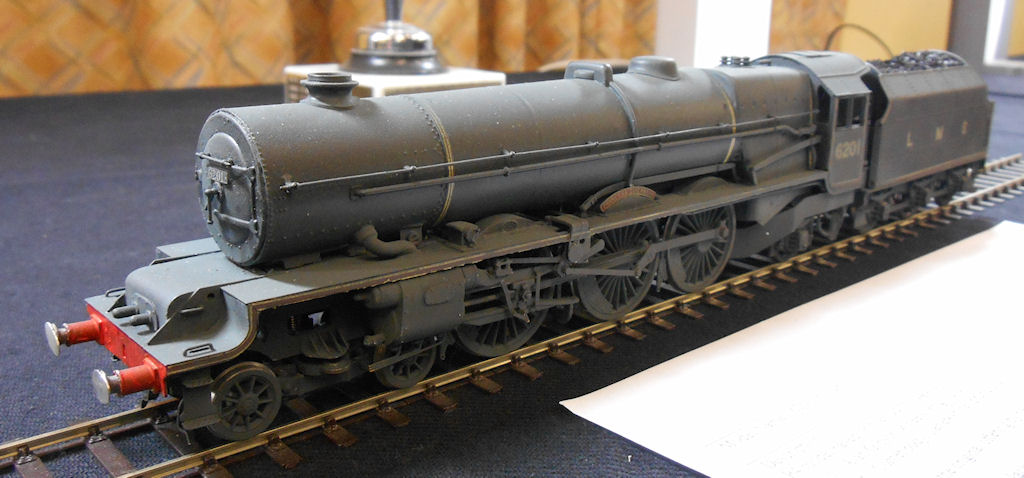 Phil’s second model is LMS Pacific loco 6201 Princess Elizabeth. The model has been produced to P4 standards from a Judith Edge scratch builders aid etch altered from the original offering by having the long boiler and short firebox. The locomotive has Alan Gibson wheels and a High Level motor and gearbox. The tender is a Comet body with a Lanarkshire sprung chassis with Alan Gibson wheels. The loco has been painted in 1946 LMS black livery as it would have been at the end of 1947.
Phil’s second model is LMS Pacific loco 6201 Princess Elizabeth. The model has been produced to P4 standards from a Judith Edge scratch builders aid etch altered from the original offering by having the long boiler and short firebox. The locomotive has Alan Gibson wheels and a High Level motor and gearbox. The tender is a Comet body with a Lanarkshire sprung chassis with Alan Gibson wheels. The loco has been painted in 1946 LMS black livery as it would have been at the end of 1947.
Diesel & Electric Locomotives
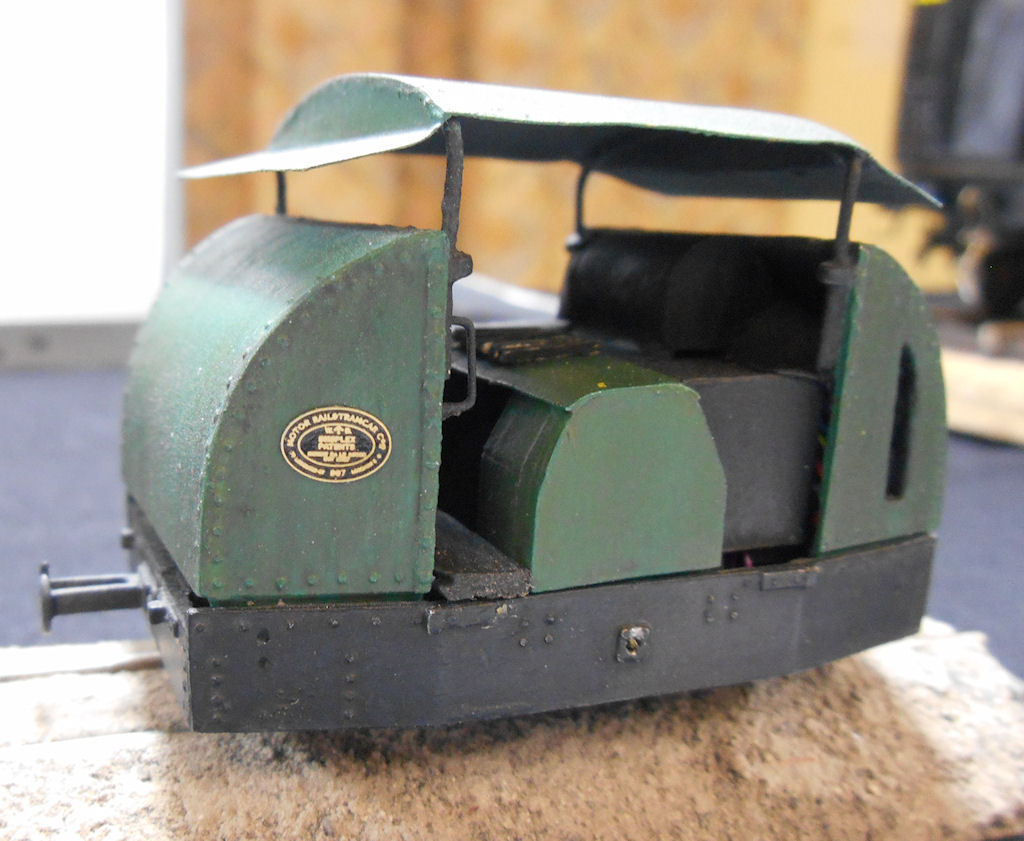 The winner of the Diesel & Electric Locomotives competition was Max Brayne for his Festiniog Railway Simplex No 507. Simplex No 507 was built by Motor Rail in 1917 for service in World War 1. The petrol loco was purchased for the Festiniog and Welsh Highland Railway in 1923 and was used as a shunter in the Portmadoc area. It was the first loco to be brought back into operation in 1954 after the closure of the original railway.
The 5.5mm scale model started as a white metal 'Armoured Simplex' kit from Malcolm Savage Models. It has been modified into a 'Protected Simplex' type with a scratch built roof and a plasticard interior. The model represents the condition upon arrival to the F&WHR. The loco uses a Bemo HOm TM 2/2 chassis for prototypically slow running and has been fitted with DCC sound.
The winner of the Diesel & Electric Locomotives competition was Max Brayne for his Festiniog Railway Simplex No 507. Simplex No 507 was built by Motor Rail in 1917 for service in World War 1. The petrol loco was purchased for the Festiniog and Welsh Highland Railway in 1923 and was used as a shunter in the Portmadoc area. It was the first loco to be brought back into operation in 1954 after the closure of the original railway.
The 5.5mm scale model started as a white metal 'Armoured Simplex' kit from Malcolm Savage Models. It has been modified into a 'Protected Simplex' type with a scratch built roof and a plasticard interior. The model represents the condition upon arrival to the F&WHR. The loco uses a Bemo HOm TM 2/2 chassis for prototypically slow running and has been fitted with DCC sound.
Coaching Stock and NPCS
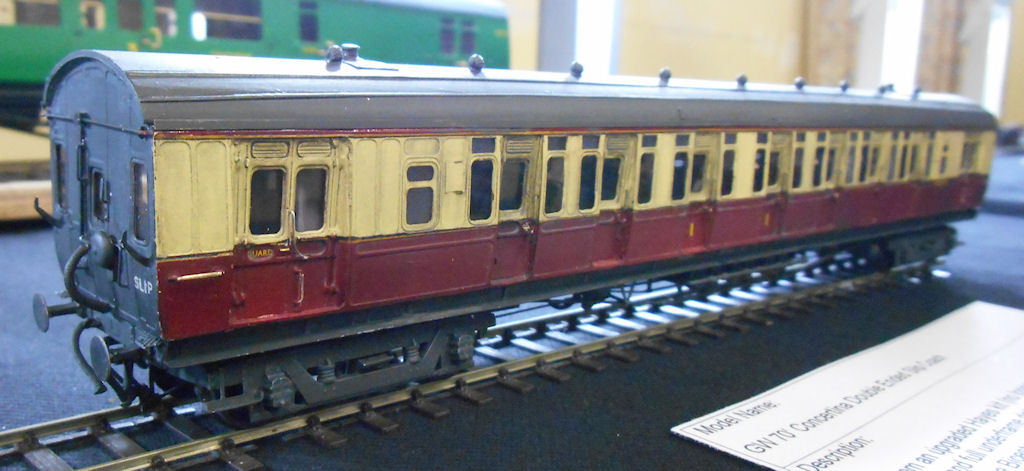 The winner of the Coaching Stock and NPCS competition was Tim Peacock for his GW 70' Concertina Double Ended Slip Coach. Prototypes lasted to late 1959 and could be seen on the Bicester slip working. They were known as Concertinas because of the in/out nature of the doors and sides. The model was built from an upgraded Hayes kit (no longer available). Extra detailing has been added including a full underframe and interior. This one is a tricompo.
The winner of the Coaching Stock and NPCS competition was Tim Peacock for his GW 70' Concertina Double Ended Slip Coach. Prototypes lasted to late 1959 and could be seen on the Bicester slip working. They were known as Concertinas because of the in/out nature of the doors and sides. The model was built from an upgraded Hayes kit (no longer available). Extra detailing has been added including a full underframe and interior. This one is a tricompo.
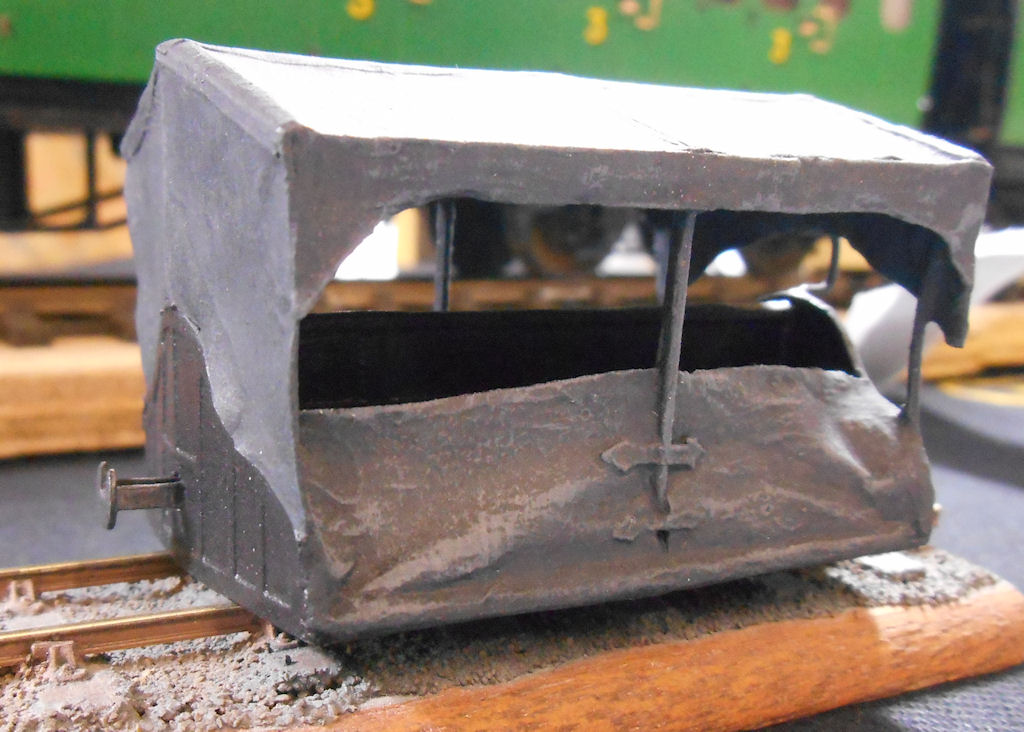 The runner up was Max Brayne for his Festiniog Railway Open Carriage. Two of these carriages were built by Brown, Marshall & Co of Birmingham for the Festiniog Railway in 1864. They were part of a fleet of carriages that formed the first official passenger train service on a narrow gauge railway anywhere in the world. Shortly after entering service, a canvas awning was added to these primitive vehicles to provide some weather protection and this is the condition the model represents. After a period of running as enclosed observation carriages, one of them still exists today and is once again in Victorian condition and runs occasionally with other vintage rolling stock. The 5.5mm scale model is made from a brass 'scratch aid' by Worsley Works with the awning frame fabricated from brass wire. The canvas itself is made from tape.
The runner up was Max Brayne for his Festiniog Railway Open Carriage. Two of these carriages were built by Brown, Marshall & Co of Birmingham for the Festiniog Railway in 1864. They were part of a fleet of carriages that formed the first official passenger train service on a narrow gauge railway anywhere in the world. Shortly after entering service, a canvas awning was added to these primitive vehicles to provide some weather protection and this is the condition the model represents. After a period of running as enclosed observation carriages, one of them still exists today and is once again in Victorian condition and runs occasionally with other vintage rolling stock. The 5.5mm scale model is made from a brass 'scratch aid' by Worsley Works with the awning frame fabricated from brass wire. The canvas itself is made from tape.
Freight and Engineers Stock
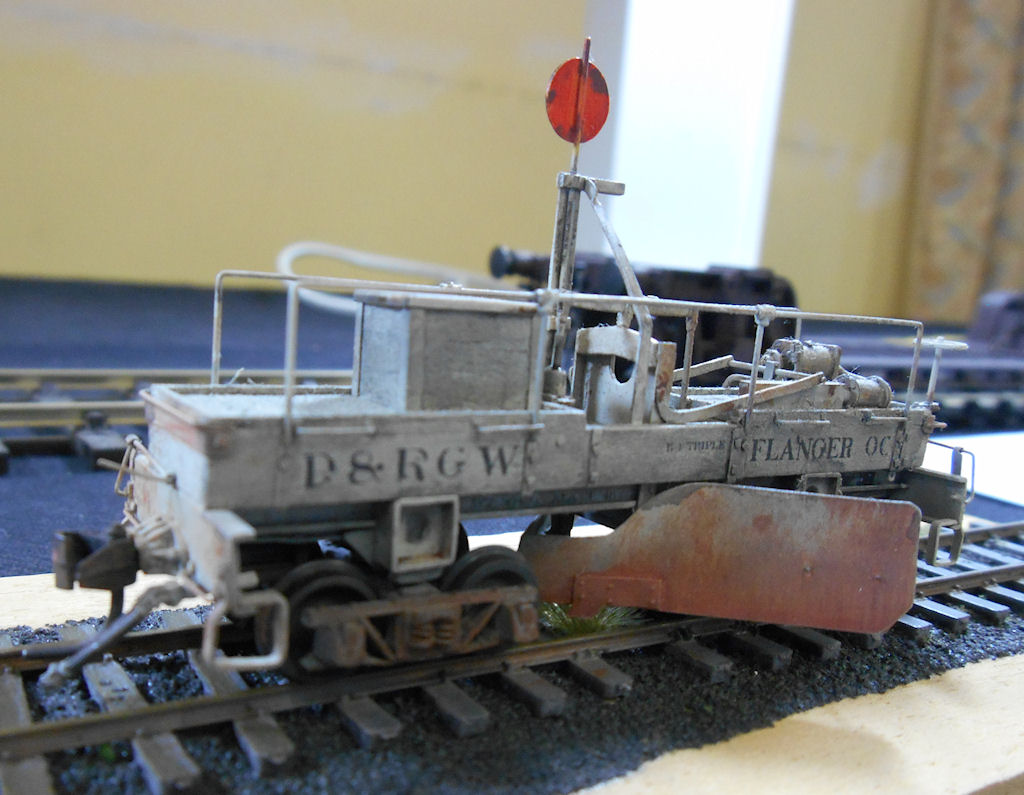 The winner of the Freight and Engineers Stock category was Mick Moignard for his D&RGW Flanger OC in HO scale, HOn3 Gauge. Drag Flangers were the Rio Grande's second line of defence against snow on the 3-foot gauge lines in Colorado and New Mexico. Hauled immediately behind a large steam loco, these devices cleared snow from between the rails and around the train and pushed it away from the rails. The blade can be lifted remotely for grade-crossings from flanger-capable locomotives. That explains the extra air-hose at the front of the car, and the switch-stand target that showed the crew that the blades had been lifted correctly.
The model is based on a wood and whitemetal kit from Rio Grande Models, but much of the whitemetal hardware was replaced with more accurate, scratchbuilt, parts in wood, brass and styrene. Grandt trucks and Kadee couplers complete the construction. It's painted, lettered and finished to match photos of the prototype from the late 40s and early 50s. The prototype exists today at the Colorado Railroad Museum in Golden, Co.
The winner of the Freight and Engineers Stock category was Mick Moignard for his D&RGW Flanger OC in HO scale, HOn3 Gauge. Drag Flangers were the Rio Grande's second line of defence against snow on the 3-foot gauge lines in Colorado and New Mexico. Hauled immediately behind a large steam loco, these devices cleared snow from between the rails and around the train and pushed it away from the rails. The blade can be lifted remotely for grade-crossings from flanger-capable locomotives. That explains the extra air-hose at the front of the car, and the switch-stand target that showed the crew that the blades had been lifted correctly.
The model is based on a wood and whitemetal kit from Rio Grande Models, but much of the whitemetal hardware was replaced with more accurate, scratchbuilt, parts in wood, brass and styrene. Grandt trucks and Kadee couplers complete the construction. It's painted, lettered and finished to match photos of the prototype from the late 40s and early 50s. The prototype exists today at the Colorado Railroad Museum in Golden, Co.
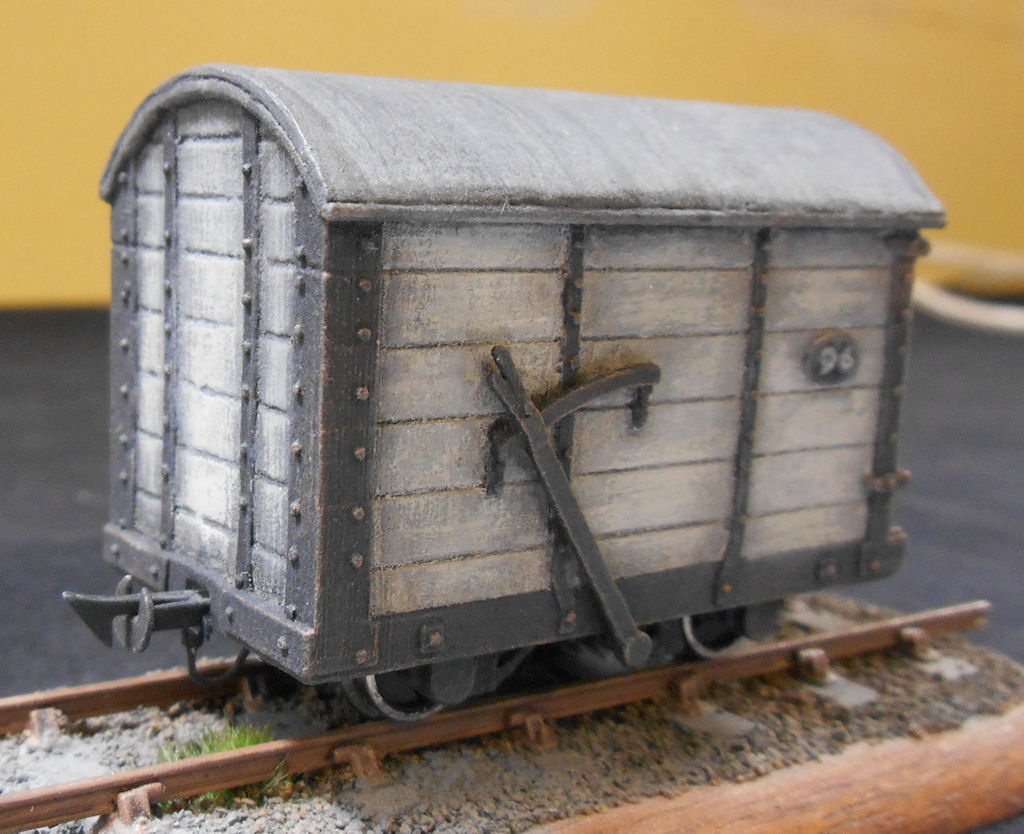 Max Brayne's Festiniog Covered Goods Van. The Festiniog Railway originally had a range of covered vans as part of a large fleet of wagons. This particular van was converted from an open wagon sometime in the early 1900s. The 5.5mm scale model is 3D printed by Shapeways in their 'Frosted Detail' material to my own 3D design. The roof is card and the wheels are from KB Scale.
Max Brayne's Festiniog Covered Goods Van. The Festiniog Railway originally had a range of covered vans as part of a large fleet of wagons. This particular van was converted from an open wagon sometime in the early 1900s. The 5.5mm scale model is 3D printed by Shapeways in their 'Frosted Detail' material to my own 3D design. The roof is card and the wheels are from KB Scale.
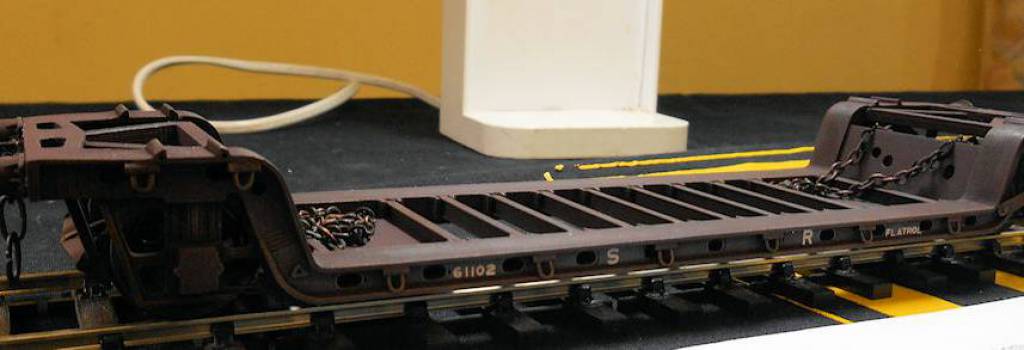 James Aitken's Southern Railway Well Wagon. A scratch built model of the Bulleid cast steel well wagon. The only commercial components are the Alan Gibson wheels and the buffers which were from the Parkside Dundas SR brake van. Solidworks was used to draw the wagon side frames in 3D with the axle box and spring assembly included. The buffer beam and cross member assembly was drawn separately and the parts printed in ABS. The four parts were glued together. The 20 little rings on the side were fabricated from plastic rod with wire, wrapped round a former, inserted into drilled holes. Brake gear was hand filed from various brass strip. As the 3D printed parts are very light, all the sheet material and the I-beams between the side were made from quite thick brass to give the wagon enough weight. Sprayed SR brown, lettered with HMRS transfers and weathered by dry brushing.
James Aitken's Southern Railway Well Wagon. A scratch built model of the Bulleid cast steel well wagon. The only commercial components are the Alan Gibson wheels and the buffers which were from the Parkside Dundas SR brake van. Solidworks was used to draw the wagon side frames in 3D with the axle box and spring assembly included. The buffer beam and cross member assembly was drawn separately and the parts printed in ABS. The four parts were glued together. The 20 little rings on the side were fabricated from plastic rod with wire, wrapped round a former, inserted into drilled holes. Brake gear was hand filed from various brass strip. As the 3D printed parts are very light, all the sheet material and the I-beams between the side were made from quite thick brass to give the wagon enough weight. Sprayed SR brown, lettered with HMRS transfers and weathered by dry brushing.

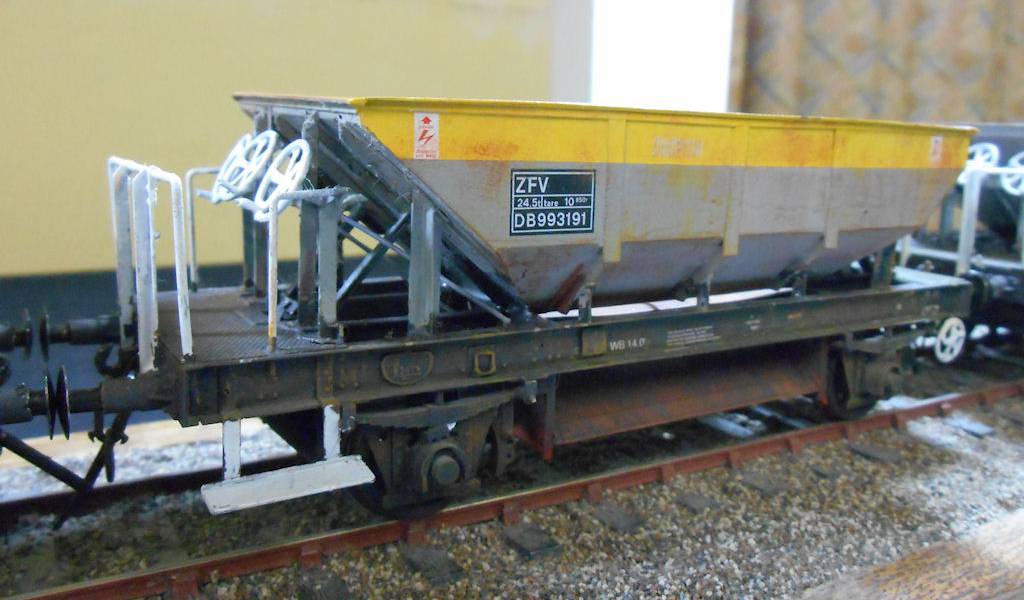
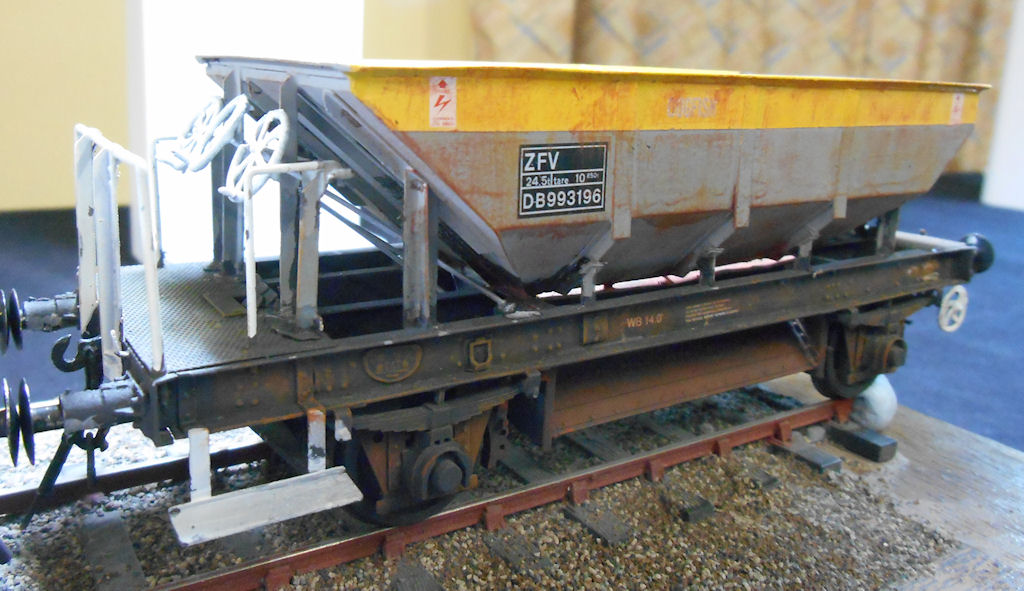 Ian Gearing's 3 Dogfish in Dutch Livery. MMP brass + Pewter Kits, enamel paints for main colour, enamel and acrylic for weathering.
Ian Gearing's 3 Dogfish in Dutch Livery. MMP brass + Pewter Kits, enamel paints for main colour, enamel and acrylic for weathering.
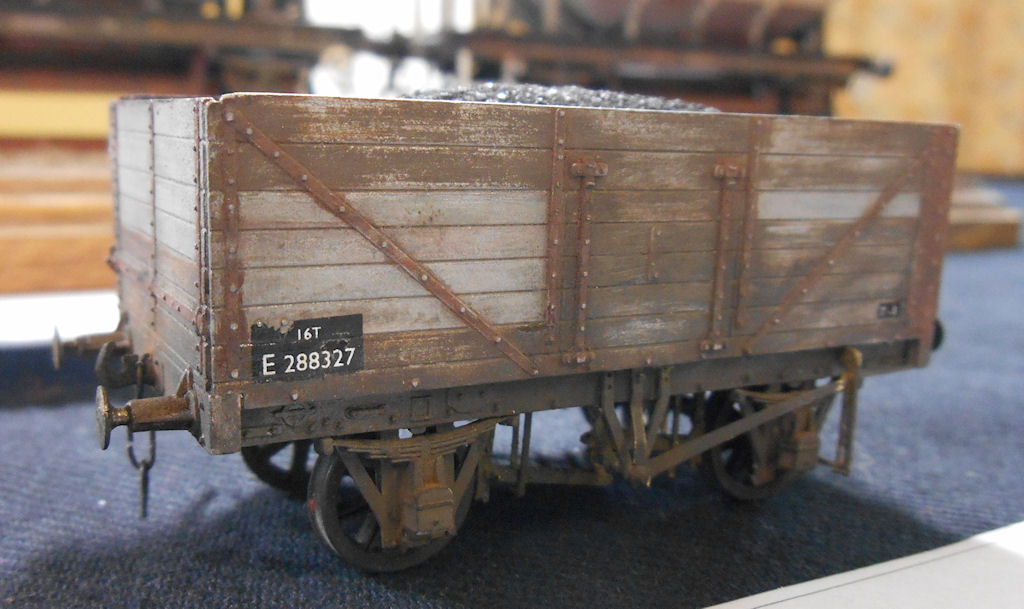 David Lane's 7 Plank Wooden Mineral Wagon. Parkside kit with sprung Masokits underframe, sprung buffers and other extra detail. The unpainted and weathered finish was copied from two colour photographs of the prototype wagon at Marlow station.
David Lane's 7 Plank Wooden Mineral Wagon. Parkside kit with sprung Masokits underframe, sprung buffers and other extra detail. The unpainted and weathered finish was copied from two colour photographs of the prototype wagon at Marlow station.
James Aitken's two Southern Railway 5 Plank Diagram 1380 wagons. These models have been made using laser cut parts and 3D printed components (except for the wheels). All components were drawn using CAD -ProgeCad for the laser cut parts and Solidworks for the 3D printed parts which are the buffer bodies, axle boxes, brake shoes and the brake lever guides. Buffer heads were turned in my lathe and the 3 link couplings are made using 1mm soft iron wire wrapped round a former. The 3D parts were made by a company called CWRailways. In fact the parts here can be seen on their O gauge website CWRailways. The final assembled model was spray painted with Precision Paints SR brown, lettered using HMRS transfers and weathered using a grey wash and dry brushing.
Road Vehicles, Boats, People, Animals etc
 The winner of The Robbie Robinson Award for road vehicles, boats, people, and animals was Paul Wright for his 1:43 model of an Austin 7. This is an Oxford Diecast Austin 7 with repainted tyres, a little acrylic dirt wash and matt varnish to tone down the gloss bodywork.
The winner of The Robbie Robinson Award for road vehicles, boats, people, and animals was Paul Wright for his 1:43 model of an Austin 7. This is an Oxford Diecast Austin 7 with repainted tyres, a little acrylic dirt wash and matt varnish to tone down the gloss bodywork.
Scenic Models: Buildings, Trees, Signals etc
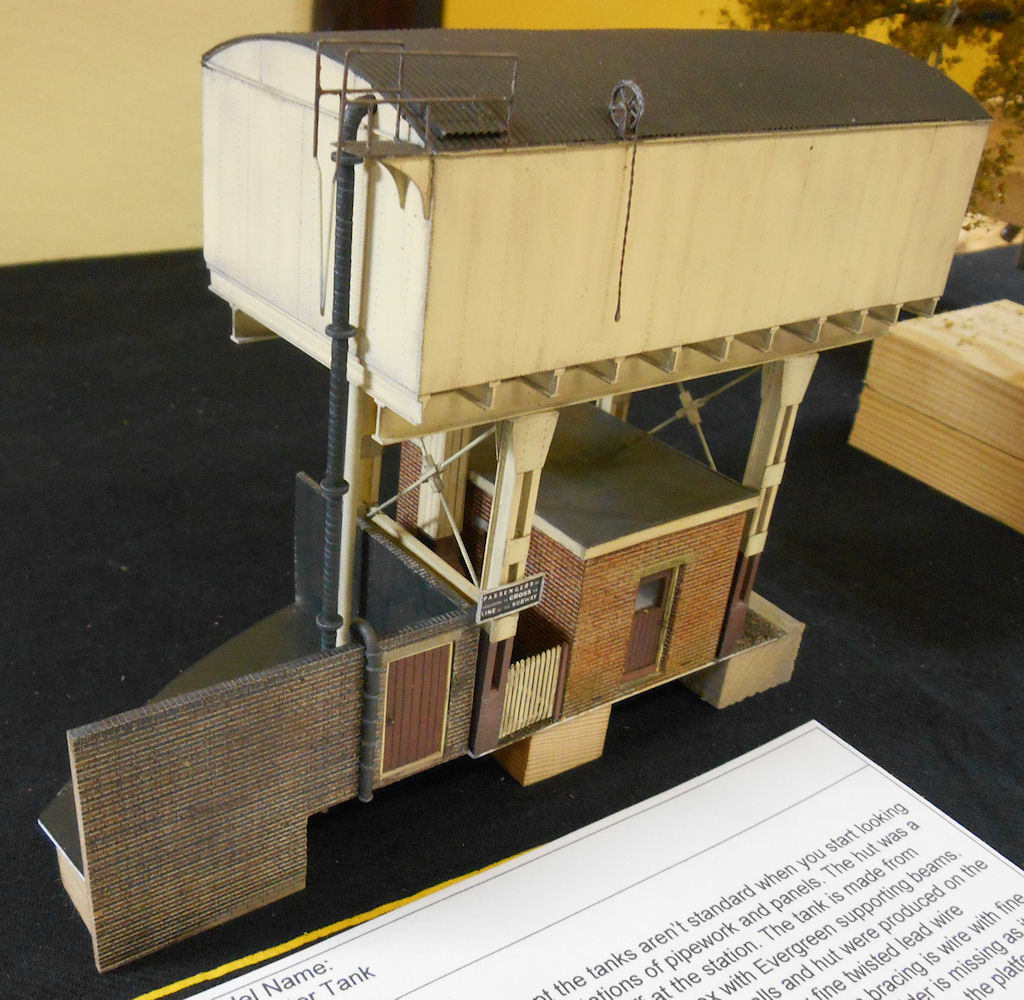 The winner of the Jack Cline Trophy for Scenic Models: Buildings, Trees and Signals was Tim Peacock for his GW Water Tank. Although this is a ‘standard’ GW water tank, there are all sorts of permutations of pipe work and panels so the tanks can’t be claimed to be standard at all. The hut was a wartime addition for inspecting staff at the station. The model tank is made from etched brass sheets on a plastic card box, with Evergreen supporting beams. The flanges and plates are hand riveted. The walls and hut were produced on the Club's laser. The water indicator plumb bob is very fine twisted lead wire (0.2mm) and was a blighter to keep straight!! The cross bracing is wire with fine bits of Evergreen square section drilled through. The ladder is missing from the model at present because it can only be added when the model is planted as it foots onto the platform ramp.
The winner of the Jack Cline Trophy for Scenic Models: Buildings, Trees and Signals was Tim Peacock for his GW Water Tank. Although this is a ‘standard’ GW water tank, there are all sorts of permutations of pipe work and panels so the tanks can’t be claimed to be standard at all. The hut was a wartime addition for inspecting staff at the station. The model tank is made from etched brass sheets on a plastic card box, with Evergreen supporting beams. The flanges and plates are hand riveted. The walls and hut were produced on the Club's laser. The water indicator plumb bob is very fine twisted lead wire (0.2mm) and was a blighter to keep straight!! The cross bracing is wire with fine bits of Evergreen square section drilled through. The ladder is missing from the model at present because it can only be added when the model is planted as it foots onto the platform ramp.
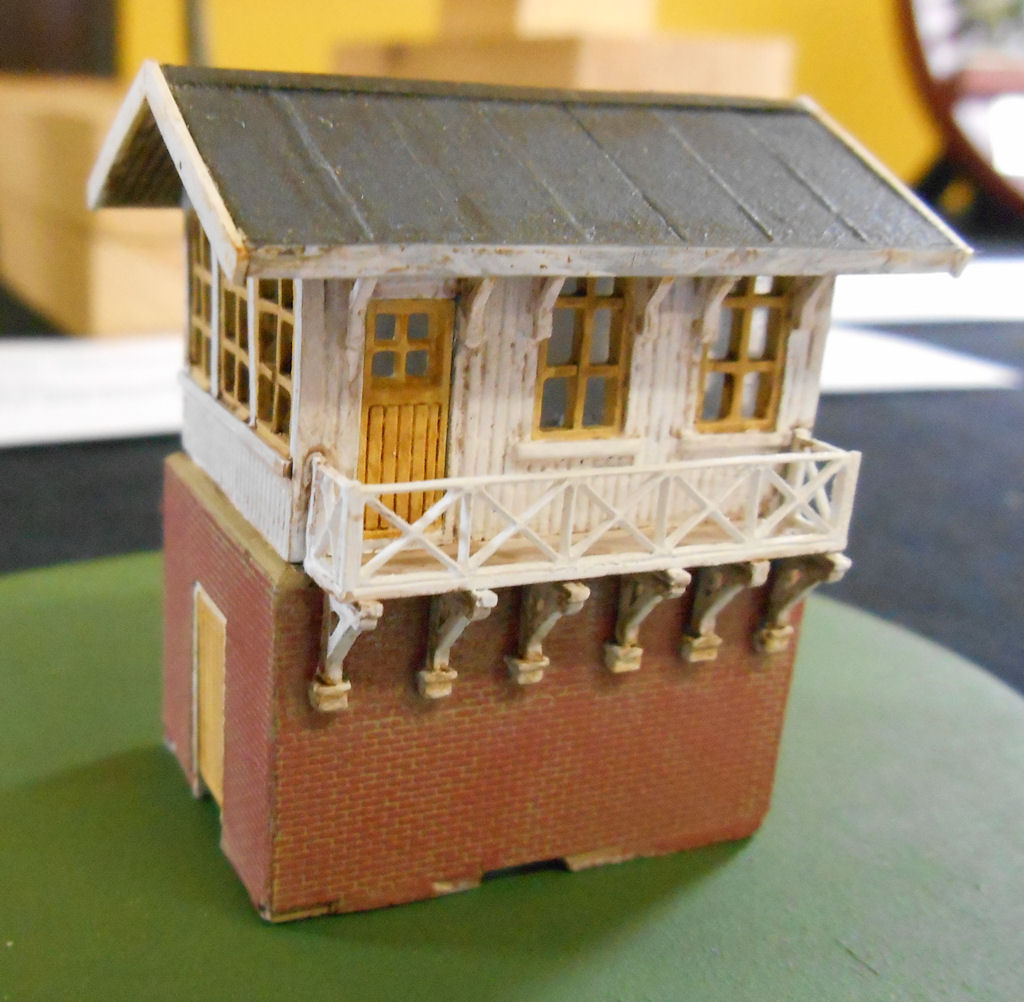 Paul Wright's Dutch Signal Box 1:160. This is a model of Boxtel signal box in the Netherlands. It has been built from a Tilly Models resin kit and painted in acrylic paint. The doors and the balcony were produced on the Club's laser cutter as the model parts were a bit chunky.
Paul Wright's Dutch Signal Box 1:160. This is a model of Boxtel signal box in the Netherlands. It has been built from a Tilly Models resin kit and painted in acrylic paint. The doors and the balcony were produced on the Club's laser cutter as the model parts were a bit chunky.
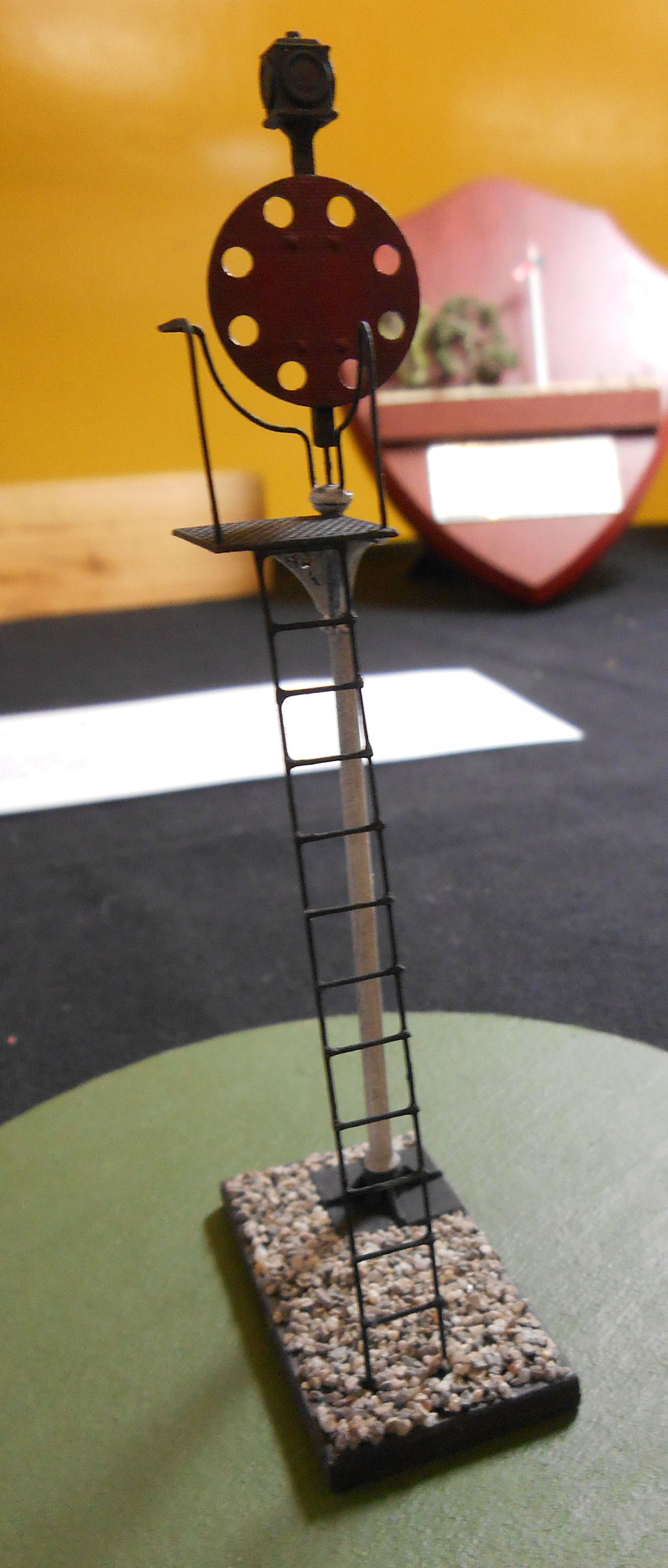 Max Brayne's Festiniog Railway Disc Signal. The Festiniog Railway had a number of this type of signal along the line and some have recently been re-erected as heritage displays in their original locations. The 5.5mm scale model is 3D printed by Shapeways in their 'Frosted Ultra Detail' material to his own 3D design created from a complete set of dimensions of the prototype. The operating rod, railings and ladder are made from brass wire.
Max Brayne's Festiniog Railway Disc Signal. The Festiniog Railway had a number of this type of signal along the line and some have recently been re-erected as heritage displays in their original locations. The 5.5mm scale model is 3D printed by Shapeways in their 'Frosted Ultra Detail' material to his own 3D design created from a complete set of dimensions of the prototype. The operating rod, railings and ladder are made from brass wire.
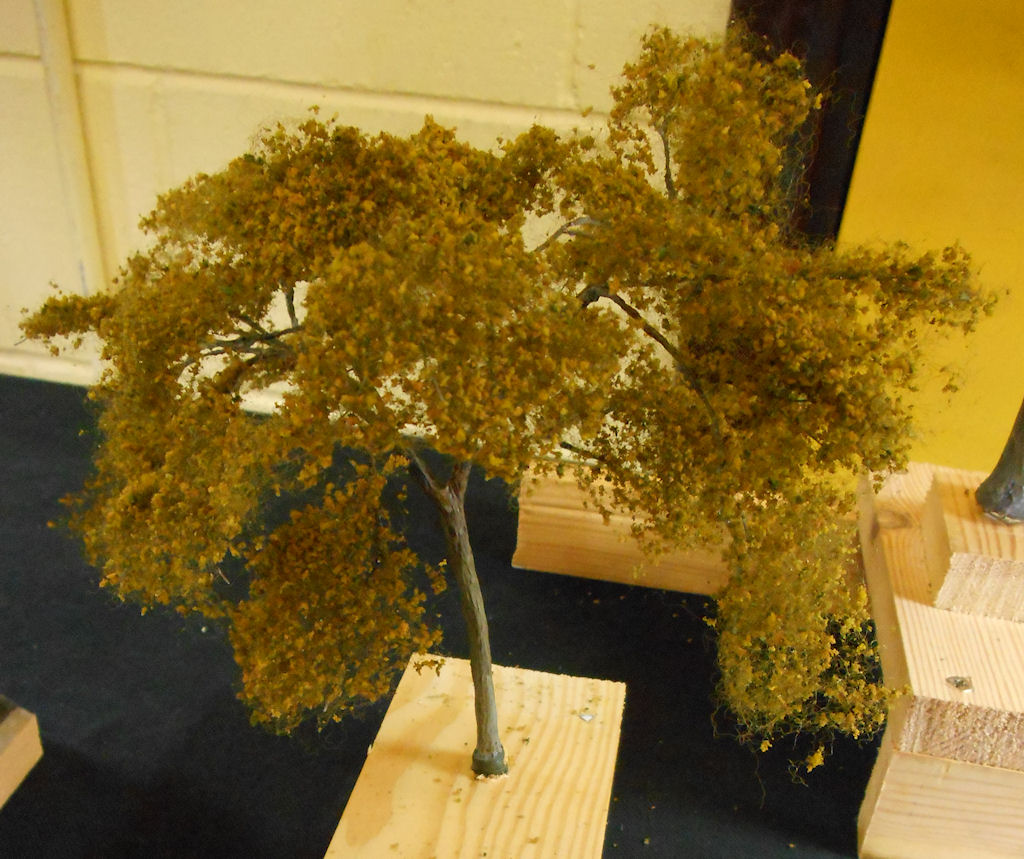 A tree from Paul Wright. This is of unknown species constructed from twisted florists wire, acrylic paste bark and Heki foliage.
A tree from Paul Wright. This is of unknown species constructed from twisted florists wire, acrylic paste bark and Heki foliage.
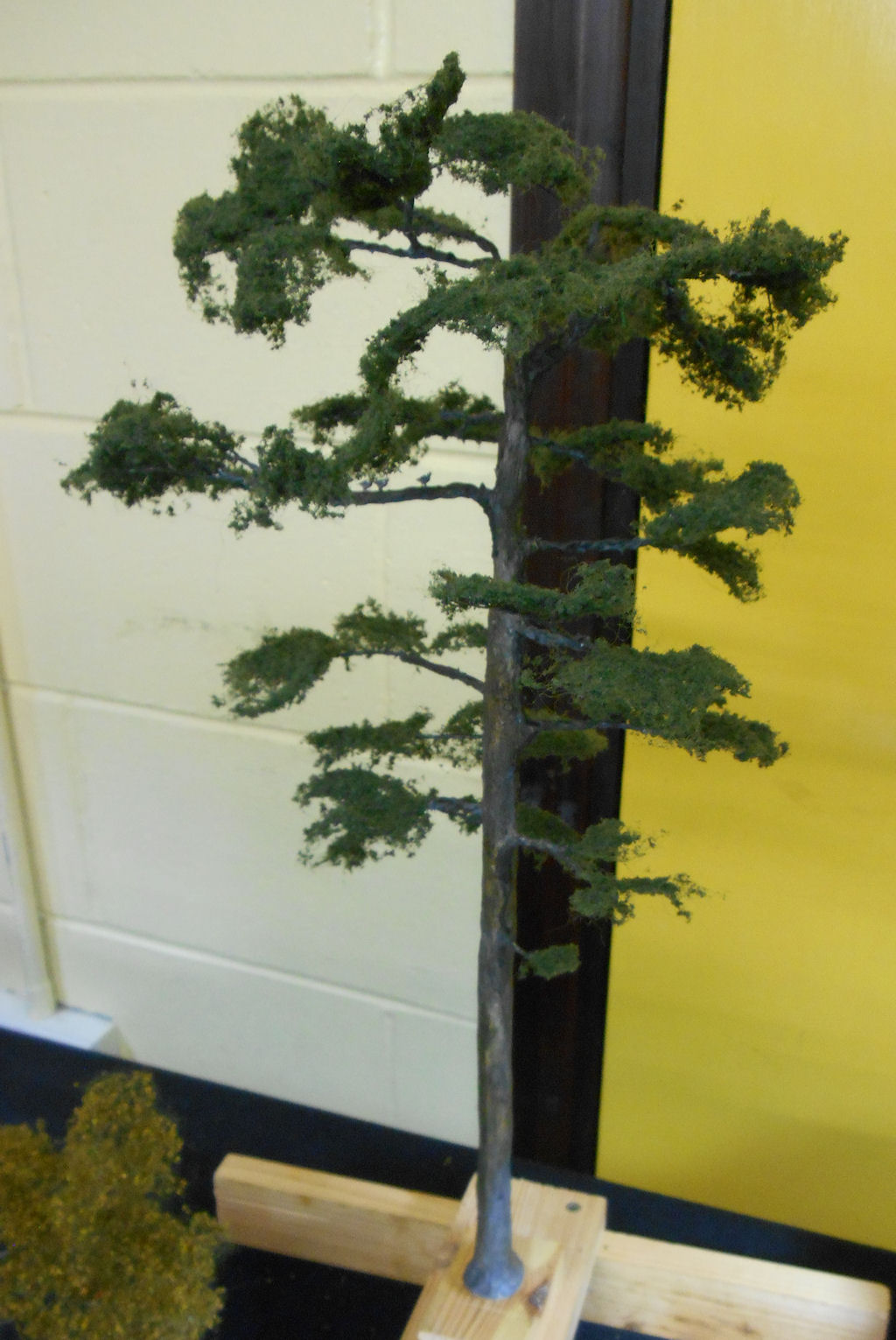 Another tree from Paul Wright. This one is a 75 foot Scots Pine for Okehampton [1:43 scale]. It has been built with a stainless steel threaded rod at the centre, florists wire for the structure and then wood filler for the bark texture, which has been painted with acrylics. The foliage is from Woodland Scenics. There are 3 pigeons sitting in the tree.
Another tree from Paul Wright. This one is a 75 foot Scots Pine for Okehampton [1:43 scale]. It has been built with a stainless steel threaded rod at the centre, florists wire for the structure and then wood filler for the bark texture, which has been painted with acrylics. The foliage is from Woodland Scenics. There are 3 pigeons sitting in the tree.
Aylesbury Town 4mm Model Project
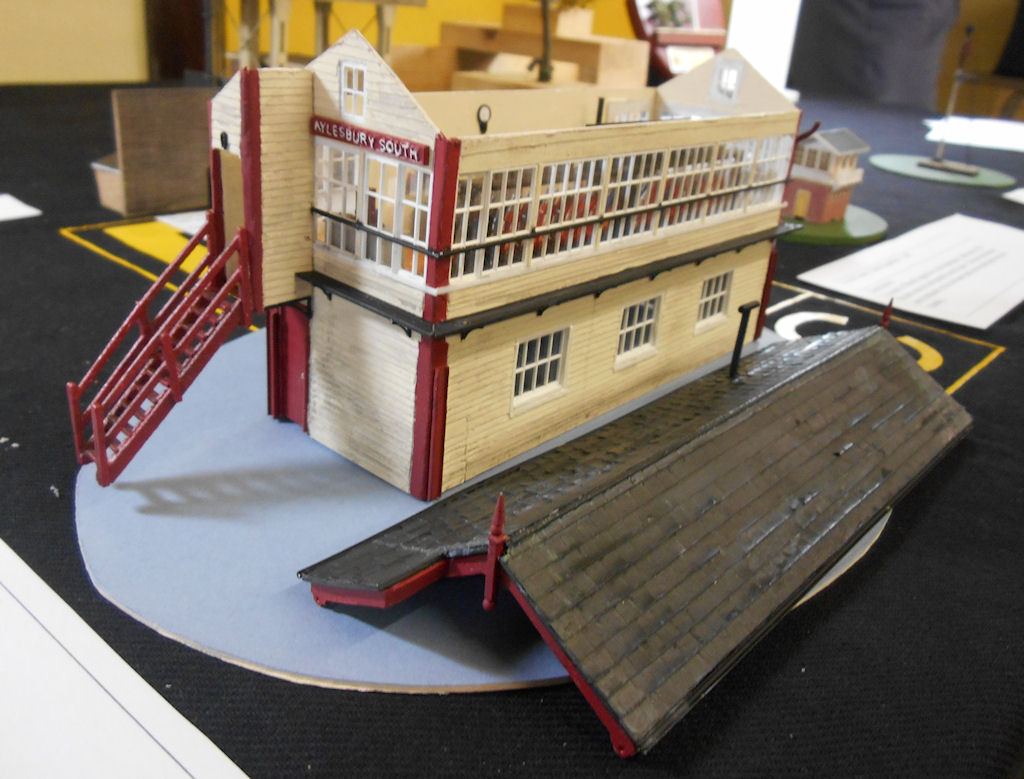
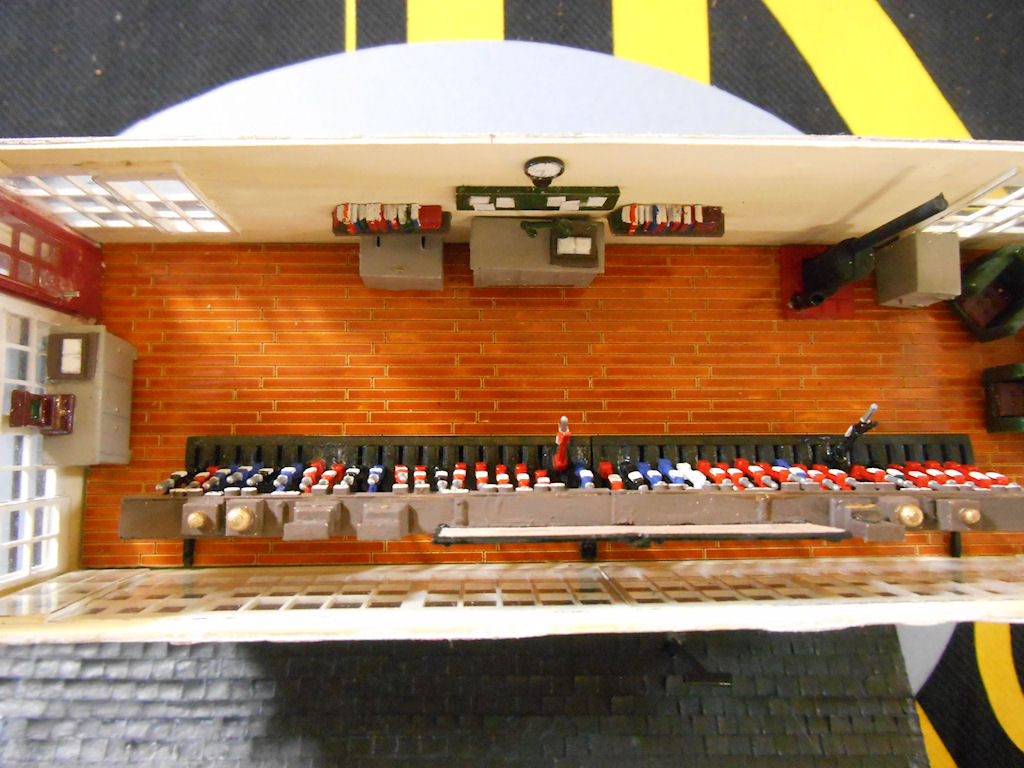 This model of Aylesbury South Signal Box was produced by Gary Day, who was the winner of the Chairman’s Cup. The model has been scratch built from laser cut Romark, based on scale plans and drafted by the modeller. The timber cladding and roof tiles were recreated with printer paper. The interior has been constructed using Ratio kits, suitably detailed and painted. Even the track diagram is an accurate representation by editing a photograph of the original plan. The stairs have been constructed using an Ancorton Model kit, suitably modified to reflect the original. The roof guttering, drain pipes, chimney and the corner supports are represented using appropriate brass and aluminium sections from Eileen's Emporium. Modified GWR Scale Link finials finish off the structure.
This model of Aylesbury South Signal Box was produced by Gary Day, who was the winner of the Chairman’s Cup. The model has been scratch built from laser cut Romark, based on scale plans and drafted by the modeller. The timber cladding and roof tiles were recreated with printer paper. The interior has been constructed using Ratio kits, suitably detailed and painted. Even the track diagram is an accurate representation by editing a photograph of the original plan. The stairs have been constructed using an Ancorton Model kit, suitably modified to reflect the original. The roof guttering, drain pipes, chimney and the corner supports are represented using appropriate brass and aluminium sections from Eileen's Emporium. Modified GWR Scale Link finials finish off the structure.
